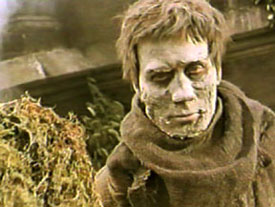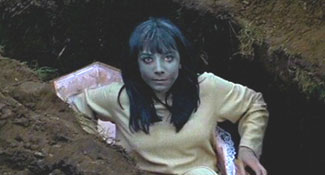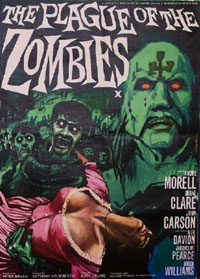A zombie cult in Victorian Cornwall is shown in the opening sequence of The Plague of the Zombies (1966). The cult's members are performing their evil rites, overseen by a masked priest. By their voodoo efforts, & to the sound of swiftly beaten congra drums, they are causing a woman (Jacqueline Pearce) in a distant location to become a tortured soul.
 You'll know right from this scene whether or not this is your kind of film. For me, I quite disliked it, as it introduces us to an array of racist attitudes & images regarding Haitian religion, merely to tell what I found to be a fairly rotten story. You'll know right from this scene whether or not this is your kind of film. For me, I quite disliked it, as it introduces us to an array of racist attitudes & images regarding Haitian religion, merely to tell what I found to be a fairly rotten story.
Sir James Forbes (Andre Morrell, the film's only real asset) is a kind of detective of occult evils pitting a scientific mind (but also his faith) against what he regards superstitious mind which he would apparently define as belief in anything but his own Christianity.
He investigates the horrors that have been threatening the wife of his friend, a village doctor (Brook Williams). His poking about soon puts his own daughter (Diane Clare) at risk, until it boils down to "scientist versus wizard" (John Carson).
There are none of Hammer Studios' more thrilling actors in this, though Andre Morrell does come close. This story requires the viewer to embrace the notion that Cornwall of the 1860s was on the edge of the civilized world, that all interest in magic is evil, that Haitians in particular & everything to do with Haiti constitutes pure evil, & the most fun use for magic powers is to molest pretty ladies from afar.
Despite that it impresses me not one whit, Plague of the Zombies is by others highly regarded for its influences in the "history" of cinematic zombies, for its gaudy sets, costumes, & technicolor to impress the impressionable of 1966, when decapitation by means of shovel was still pretty extreme, gorier than generally expected.
 To an extent this film represents an "end piece," the last allegedly great example of a certain type of zombie that began in Hollywood of the 1930s & was not displaced until Night of the Living Dead (1968) jettisoned the racist stuff & decided zombies were interchangeable with ghouls with nothing to do with Haiti. To an extent this film represents an "end piece," the last allegedly great example of a certain type of zombie that began in Hollywood of the 1930s & was not displaced until Night of the Living Dead (1968) jettisoned the racist stuff & decided zombies were interchangeable with ghouls with nothing to do with Haiti.
Before Living Dead zombiism was not about flesh-eating corpse-people, but was a vengeful commercial process for the production of slaves or soldiers. In Plague zombies are kind of interchangeable with South African diamond mine laborers in service to white people -- a comparison that may now seem all too apparent but which no one in the '60s intended or realized.
Living Dead didn't entirely squelch the old-time cinematic slave-zombies, as Plague appears to have spawned a great horde of Italian zombies that are even worse. So Plague of the Zombies can be viewed as a primer for a whole sub-genre of crapola which arose in its wake. England's Hammer Films itself seems to have realized it was putrid as they never made another zombie flick, leaving them to the even cheaper producers who delighted in subtitling eurotrash horrors.
Enough people insist it's a masterpiece, however, that I have to shrug & suppose it is, at least, exemplary of a certain type of visual style, for its hair-dos, & costumes, & a type of tale-spinning pecular to late 1960s extravaganza of kitsch. Anyone who saw it when they were fifteen years old might be forgiven if they connect with it still, as a nostalgic experience; but that younger viewers get something out of it, well, much worse does have its fandom, so why not this.
Continue to more zombie films:
Shadows of the Dead (2004) & Grave Mistake (2008)
copyright © by Paghat the Ratgirl
|

 You'll know right from this scene whether or not this is your kind of film. For me, I quite disliked it, as it introduces us to an array of racist attitudes & images regarding Haitian religion, merely to tell what I found to be a fairly rotten story.
You'll know right from this scene whether or not this is your kind of film. For me, I quite disliked it, as it introduces us to an array of racist attitudes & images regarding Haitian religion, merely to tell what I found to be a fairly rotten story. To an extent this film represents an "end piece," the last allegedly great example of a certain type of zombie that began in Hollywood of the 1930s & was not displaced until Night of the Living Dead (1968) jettisoned the racist stuff & decided zombies were interchangeable with ghouls with nothing to do with Haiti.
To an extent this film represents an "end piece," the last allegedly great example of a certain type of zombie that began in Hollywood of the 1930s & was not displaced until Night of the Living Dead (1968) jettisoned the racist stuff & decided zombies were interchangeable with ghouls with nothing to do with Haiti.